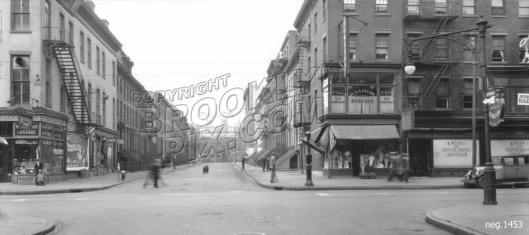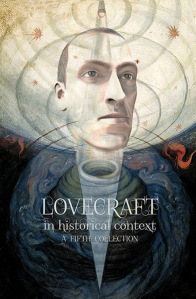Rheinhart Kleiner opened his memoir of Lovecraft, “Bards and Bibliophiles”, in…
a little coffee shop at the corner of Court and Schermerhorn Streets, Brooklyn” (Lovecraft Remembered, p.188)
I may have found a picture of this cafe, titled “Schermerhorn Street looking north to Court Street, 1928” From Brooklypix…
Looking at the other available views of Schermerhorn/Court, it seems there were no other corner cafes there in the 1920s. The “Scotch Bakery and Lunch Room” can be seen on the right of the picture, and there is also a sculptural sign for it on the right-hand lamp post.
At the corner cafe Lovecraft and the gang would sup a 1 a.m. coffee and peruse the early morning editions of the New York newspapers, often before setting out for a long night walk. …
This essay has been replaced by the essay in my new book of revised, expanded, and footnoted versions of my recent Tentaclii essays, Lovecraft in Historical Context: fifth collection.



It’s amazing where chasing a bit of Lovecraft trivia can lead one: chase down a simple cafe, and discover a major new and previously totally unknown source for “The Horror at Red Hook”
The Brooklyn Daily Eagle of 9th August 1908 added that Haslett would each day also make a later trip to the Court and Schermerhorn bakery for “his daily pie”. It also noted that the garden, kept immaculate despite the decrepitude of the boarded-up mansion, was reputed among the credulous to be tended by ghosts, said to emerge from the house at night. In another point of similarity with “Red Hook”, the same article noted that garden was where… “more than half a century ago the Hasletts gave lawn fetes and garden parties that were the gayest events in Brooklyn”.
The Brooklyn Daily Eagle of 18th May 1919 reported on what was found when the house was opened after Haslett’s death…
“rare books which would bring a covetous light to the eyes of a bibliomaniac … dust-covered book cases containing volumes so old that they are on the point of falling to pieces … a Greek Testament running back to 1500 and something … upstairs were hundreds and hundreds of other books … Italian books, Spanish books, Latin, Greek and French works… baskets full of letters written from Naples, Rome, Paris…”
The books and finer art objects apparently later went to the Brooklyn Institute.
Another point of similarity with “Red Hook” is the real-estate empire held by Haslett, which appears to be where most of his wealth lay. The Brooklyn Daily Eagle of 6th July 1935 interviewed his old carpenter, the then 90-year old Otto Erble. Erble had a collection of clippings and papers on Haslett, and still lived on what was once the Haslett estate. Erble stated they Haslett had owned “much other property” in the area.
The Brooklyn Daily Eagle of 25th March 1922 reported that the cleaned and cleared old mansion had been let on a ten-year lease to a doctor of “electro-therapeutics”. This was just a few weeks before Lovecraft was about to first set foot in New York City.